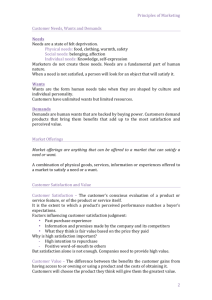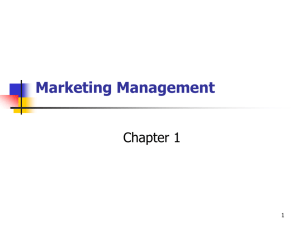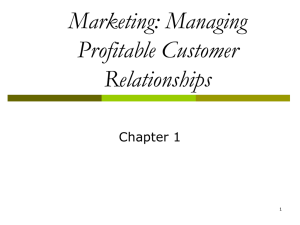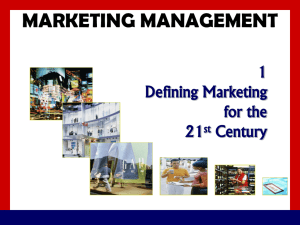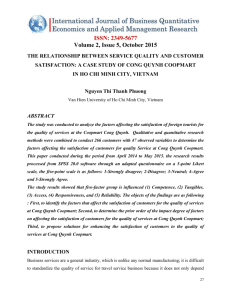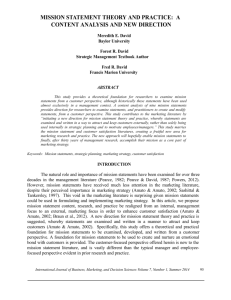company orientations towards the market place: a discussion
advertisement
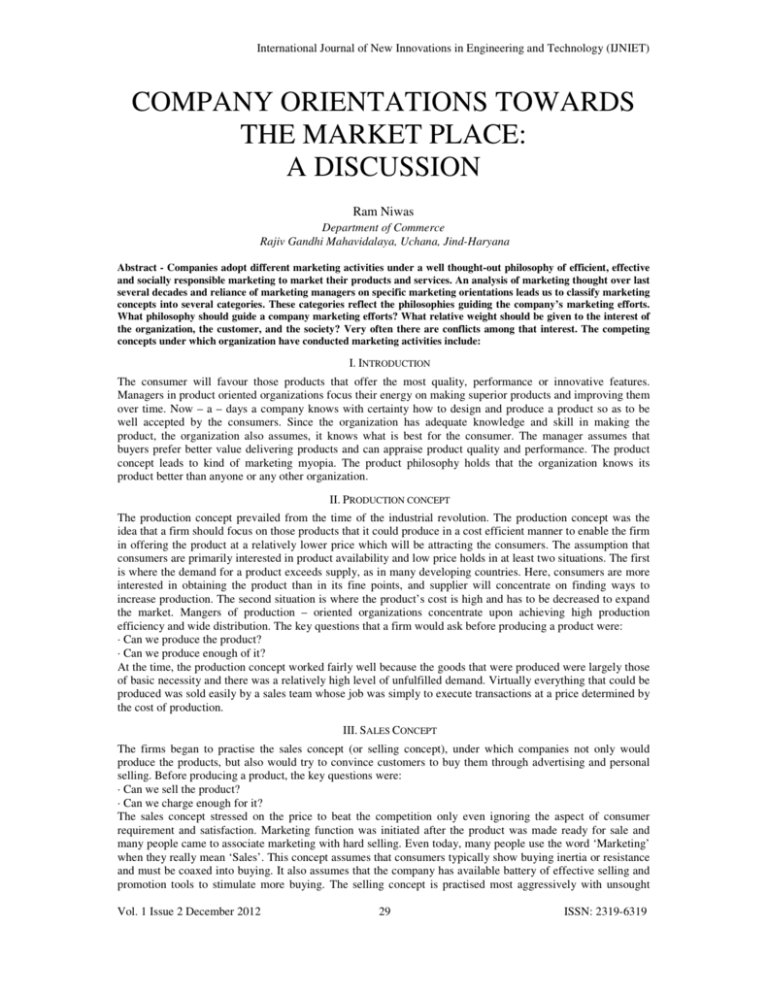
International Journal of New Innovations in Engineering and Technology (IJNIET) COMPANY ORIENTATIONS TOWARDS THE MARKET PLACE: A DISCUSSION Ram Niwas Department of Commerce Rajiv Gandhi Mahavidalaya, Uchana, Jind-Haryana Abstract - Companies adopt different marketing activities under a well thought-out philosophy of efficient, effective and socially responsible marketing to market their products and services. An analysis of marketing thought over last several decades and reliance of marketing managers on specific marketing orientations leads us to classify marketing concepts into several categories. These categories reflect the philosophies guiding the company’s marketing efforts. What philosophy should guide a company marketing efforts? What relative weight should be given to the interest of the organization, the customer, and the society? Very often there are conflicts among that interest. The competing concepts under which organization have conducted marketing activities include: I. INTRODUCTION The consumer will favour those products that offer the most quality, performance or innovative features. Managers in product oriented organizations focus their energy on making superior products and improving them over time. Now – a – days a company knows with certainty how to design and produce a product so as to be well accepted by the consumers. Since the organization has adequate knowledge and skill in making the product, the organization also assumes, it knows what is best for the consumer. The manager assumes that buyers prefer better value delivering products and can appraise product quality and performance. The product concept leads to kind of marketing myopia. The product philosophy holds that the organization knows its product better than anyone or any other organization. II. PRODUCTION CONCEPT The production concept prevailed from the time of the industrial revolution. The production concept was the idea that a firm should focus on those products that it could produce in a cost efficient manner to enable the firm in offering the product at a relatively lower price which will be attracting the consumers. The assumption that consumers are primarily interested in product availability and low price holds in at least two situations. The first is where the demand for a product exceeds supply, as in many developing countries. Here, consumers are more interested in obtaining the product than in its fine points, and supplier will concentrate on finding ways to increase production. The second situation is where the product’s cost is high and has to be decreased to expand the market. Mangers of production – oriented organizations concentrate upon achieving high production efficiency and wide distribution. The key questions that a firm would ask before producing a product were: · Can we produce the product? · Can we produce enough of it? At the time, the production concept worked fairly well because the goods that were produced were largely those of basic necessity and there was a relatively high level of unfulfilled demand. Virtually everything that could be produced was sold easily by a sales team whose job was simply to execute transactions at a price determined by the cost of production. III. SALES CONCEPT The firms began to practise the sales concept (or selling concept), under which companies not only would produce the products, but also would try to convince customers to buy them through advertising and personal selling. Before producing a product, the key questions were: · Can we sell the product? · Can we charge enough for it? The sales concept stressed on the price to beat the competition only even ignoring the aspect of consumer requirement and satisfaction. Marketing function was initiated after the product was made ready for sale and many people came to associate marketing with hard selling. Even today, many people use the word ‘Marketing’ when they really mean ‘Sales’. This concept assumes that consumers typically show buying inertia or resistance and must be coaxed into buying. It also assumes that the company has available battery of effective selling and promotion tools to stimulate more buying. The selling concept is practised most aggressively with unsought Vol. 1 Issue 2 December 2012 29 ISSN: 2319-6319 International Journal of New Innovations in Engineering and Technology (IJNIET) goods, those goods that buyers normally do not think of buying, such as, insurance, encyclopaedias, and funeral plots. These industries have perfected various techniques to locate prospects and hard-sell them on their product’s benefits. Most firms practise the selling concept when they have overcapacity. Their aim is to sell what they make rather than make what the market wants. IV. THE MARKETING CONCEPT After World War II, the variety of products increased as a result of the worldwide impact of industrial revolution and hard selling no longer could be relied upon to generate sales. With increased discretionary income, customers could afford to be selective and buy only those products that precisely met their changing needs, and these needs were not immediately obvious. The key questions became: What do the customers want? Can we develop it while they still want it? How can we keep our customers satisfied? In response to these discerning customers, firms began to adopt the marketing concept, which involves: Focusing on customer needs before developing the product. Aligning all functions of the company to focus on those needs. Realizing a profit by successfully satisfying customer needs over the long-term. When firms first began to adopt the marketing concept, they typically set up separate marketing departments whose objective was to satisfy customer needs. Often these departments were sales departments with extended responsibilities. While this expanded sales department structure with extended responsibilities can be found in some companies today, many firms have structured themselves into marketing organizations having a companywide customer focus. Since the entire organization exists to satisfy customer needs, nobody can neglect a customer issue by declaring it a “marketing problem” - everybody must be concerned with customer satisfaction. The marketing concept relies upon marketing research to define market segments, their size, and their needs. To satisfy those needs, the marketing team makes decisions about the controllable parameters of the marketing mix. The marketing concept rests on four pillars: Target market, Customer needs, integrated marketing and Profitability. The marketing concepts adopt an outside –in perspectives. It starts with a well – defined market, focuses on customer needs, integrates all the activities that will affect customer and produces profits by satisfying customers. V. THE SOCIETAL MARKETING CONCEPT The societal marketing concept holds that the organization’s task is to determine the needs, wants and interest of target markets and to deliver the desired satisfaction more effectively and efficiently in a cost effective manner than the competitors which preserve or enhance the well - being of the consumers and the society as well. It calls upon marketers to build social and ethical considerations into their market practices. They must balance and juggle the often conflicting criteria of company profits, consumer want and satisfaction, and public interest. Yet a number of companies have achieved notable sales and profit gains through adopting and practising the societal marketing concept. Four categories of products have been identified and classified in terms of long term benefits and immediate satisfaction. These are as follows: I. Deficient products, which bring neither long-run nor short term benefits. II. Pleasing products, which bring a high level of immediate satisfaction, but can cause harm to the society in the long run. III. Salutary products, which bring low short term satisfaction, but benefit the society on the long run. IV. Desirable products, which combine long-run benefit and immediate satisfaction. Societal marketing suggested that for the well-being of the society, the deficient products should be eliminated from the market, pleasing and salutary products should go through a product modification process to reach the fourth category, by incorporating the missing short term benefits into salutary products and the long term benefits into pleasing products, and the companies’ ultimate goal should be to develop desirable products. This way, rather than focusing on selling a product, which can be good or bad for the consumers, the main focus is on consumer and society well-being. VI. SOCIAL MARKETING Social marketing as a holistic form of marketing incorporates social responsibility marketing and understanding broader concerns and the ethical, environmental, legal and social contexts of marketing activities and programme. It involves a focus on the long run interests of consumers and the society. This concept holds that the organization’s task is to determine the needs, wants and interests of target markets and to deliver the desired satisfaction more effectively and efficiently than the competitors are, in a way that serves or enhances the consumer and the society’s wellbeing. This concept calls on marketers to translate social and ethical Vol. 1 Issue 2 December 2012 30 ISSN: 2319-6319 International Journal of New Innovations in Engineering and Technology (IJNIET) considerations into their Social marketing employs principles and techniques to advance a social cause, idea or behaviour. Whether social marketers are promoting ideas or social practices, their ultimate goal is to alter behaviour. In order to accomplish this behavioural change, social marketers set measurable objectives, research their target groups’ needs, and then target their ‘‘products”. REFERENCES [1] [2] [3] [4] [5] [6] [7] [8] [9] Kotler P., Marketing Management. Kotler. Keller, Marketing Management. Gupta C.B., Marketing Management. Leong siew Meng, Marketing Management : An Asian Perspective. Dalrymple Douglas J., Basic Marketing Management Keller Kevin Lane, Principles of Marketing Management. Agnihoti Prafulla, Haque Ehsan UI, Armstrong and Kotler Marketing Management (A South Asian Prespective) Perreault William D., Essentials of Marketing Sarengi S.K., Marketing Management Vol. 1 Issue 2 December 2012 31 ISSN: 2319-6319
